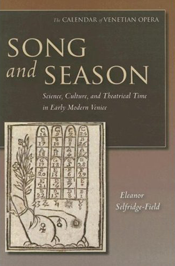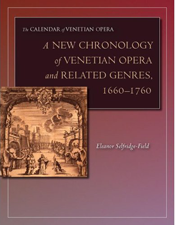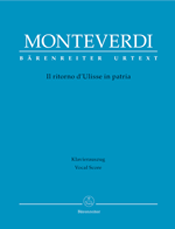Eleanor Selfridge-Field. Song and Season: Science, Culture, and
Theatrical Time in Early Modern Venice and Song and Season: A New
Chronology of Venetian Opera and Related Genres, 1660-1760. Stanford,
California: Stanford University Press, 2007.
Monteverdi’s operas have reached new heights of popularity in recent
years, exponentially exceding performances that occurred during his lifetime.
L’incoronazione di Poppea has long been prized for its sensuality,
musical flexibility, and depiction of the misuse of political power;
acceptance of Poppea as a masterpiece, perhaps, has led to more
performances of his other two surviving operas, and Il ritorno d’Ulisse
in patria (Ulysses’ return to his homeland, 1640/41) has increasingly
been the subject of new stagings. Two new editions have been issued during
recent years, and they will greatly aid in the study and appreciation of
Monteverdi’s penultimate opera. The newer of the two, that published by
Bärenreiter, is the one under review here; in order to better evaluate its
approach, I will briefly discuss two earlier editions, those of Gian
Francesco Malipiero (1930) and Alan Curtis (2002).
Malipiero thrust Monteverdi’s name and music into prominence with his
collected edition of the composer’s works (Il ritorno was
published as volume twelve in the series). Malipiero’s edition transmitted
the “original” notation of the manuscript score, but the noted composer
and musicologist also made numerous editorial interventions such as were
common during the early twentieth century; for the most part, these
suggestions appear as tempo suggestions (in parentheses) along with
“piano” and “forte” and crescendo and decrescendo instructions in the
realized continuo part.
Alan Curtis’s much later edition of Il ritorno, published in
2002 by Novello, follows along the same lines of his earlier edition of
Monteverdi’s L’incoronazione di Poppea. Curtis’s preface,
occupying some thirteen pages, covers the sources (one score, and twelve
manuscript librettos), editorial procedures, and a wealth of performance
suggestions. Curtis, in striving for accessibility to performers, regularizes
bar lines (which were not consistent during the first half of the seventeenth
century), and reduces by four the sections in triple time (originally notated
with a basic movement of whole notes and half notes, now they move by quarter
note). Curtis does not provide a realized continuo part, but he does
occasionally suggest figures, and he helpfully places those already occuring
in the manuscript in a box, thus clearly marking the separation between
editorial and original figures. Finally, the sung text appears both in
Italian and in English translation, with additional notes inserted in a
smaller typeface to accomodate extra syllables in the translation. Curtis’s
edition, then, is overtly modern in its presentation.
Bärenreiter’s new edition of the opera has been published in its
Urtext series (editions featuring the “original” versions of
musical scores). The edition, according to Bärenreiter’s high standards,
is beautifully set, and easy to read. English readers have the benefit of the
introduction as well as the critical notes appearing in English; a
translation of the libretto into English and German is also included in the
volume. Edited by Rinaldo Alessandrini, a performer and musicologist, the
score provides a striking contrast to Curtis’s, precisely because it
appears in the Urtext series. Alessandrini’s edition hews closely
to the original manuscript both in terms of music and the libretto (many
other editions of seventeenth-century opera modernize the Italian poetry;
indeed, this will be the case in the new edition of the operas of Francesco
Cavalli, to be published also by Bärenreiter). Outright notational errors
have been corrected in the score, and the critical commentary (included at
the end of the volume) provides the original versions as well as suggestions
for other passages. In order to provide an “authentic” rendering of the
score, neither the notation of the triple-time passages nor the barring have
been modernized.
In his introduction (much briefer than Curtis’s), Alessandrini discusses
seventeenth-century performance practice, and urges performers not to
over-orchestrate the sinfonie and ritornelli, as
Monteverdi’s late operas were conceived under patently different
circumstances than those operating in Mantua for his Orfeo (1607),
which featured a large and specialized orchestra (the orchestra for this
opera features two violin parts, two viola parts, and a basso continuo line).
For Ritorno and Poppea, small string orchestras with
appropriate continuo instruments should be the norm (i.e., no organ, which
has frequently been used in recordings over the past several decades). As
Alessandrini does not explain the proportions that govern the movement from
duple to triple meter, performers will have to judge for themselves–or seek
out musicological advice–regarding proper tempi; performers using this and
similar scores must, then, accustom themselves to the notion of fast-moving
whole notes.
The most controversial feature of this edition may well be
Alessandrini’s adaptation of the continuo line. While it does not contain a
full realization, in some sections nearly every bass note sports a figure of
some kind. Indeed, I have never seen such a continuo line for editions of
this repertoire. While Alessandrini’s suggestions are enclosed within bold
brackets, the distance between the opening and closing of the bracket is
often more than a single system (sometimes as many as three systems), so that
one almost forgets that the figures on the page are not Monteverdi’s. Many
of the added figures are simply not necessary, especially those that follow a
“picardy-third” cadence. On a related matter, Alessandrini claims that
the figures have been added according to the practice described in
theoretical treatises contemporary with Monteverdi, but the editor seems to
have often erred in the direction of modernity; the figures often give more
of a sense of “dominant” harmony than may be appropriate for this style
of music, and on occasion, some of the figures just seem wrong. While the
added figures presumably would make the realization more accessible to an
inexperienced keyboardist, they lead to an incredibly cluttered page, and
also suggest a more consistently rich harmony than may have been prevalent
during Monteverdi’s time. In the vocal score, these indications have been
transmitted to the realization, so that the page bears no clutter, but
Alessandrini’s harmonies, rather than those most likely implied by
Monteverdi, are guaranteed to enter the consciousness of the singers learning
the roles.
The year 2007 also marked the long-awaited publication of Eleanor
Selfridge-Field’s two related books, Song and Season: Science, Culture,
and Theatrical Time in Early Modern Venice and A New Chronology of
Venetian Opera and Related Genres, 1660-1760. The books appear under the
series title The Calendar of Venetian Opera. Both books are the
product of decades of research.
 Song and Season is a wide-ranging work that draws on a detailed
examination of Venetian cultural and theatrical history and its intersection
with concepts of civic and sacred time in the city. Selfridge-Field charts
the different methods of time-keeping current in Venice, and the resulting
effects on its well-known entertainments. For the first time we can clearly
see the different theatrical seasons practiced in the city, and how different
types of entertainment tended to be offered in different, short seasons (up
until now we have tended to refer to the Venetian theatrical seasons as
either autumn, Carnival, or Ascension). The author helpfully has a separate
chapter devoted to each of the theaters active in seventeenth- and
eighteenth-century Venice. Moreover, she discusses reciprocity that occurred
between Venice, the first great operatic center of Europe, and other regional
venues associated with trade fairs in the Veneto such as Padua, Rovigo, and
Vicenza. Selfridge-Field ably demonstrates how understanding the
“seasons” of opera in Venice helps us to understand also how opera
functioned outside the city and, indeed, outside of Italy.
Song and Season is a wide-ranging work that draws on a detailed
examination of Venetian cultural and theatrical history and its intersection
with concepts of civic and sacred time in the city. Selfridge-Field charts
the different methods of time-keeping current in Venice, and the resulting
effects on its well-known entertainments. For the first time we can clearly
see the different theatrical seasons practiced in the city, and how different
types of entertainment tended to be offered in different, short seasons (up
until now we have tended to refer to the Venetian theatrical seasons as
either autumn, Carnival, or Ascension). The author helpfully has a separate
chapter devoted to each of the theaters active in seventeenth- and
eighteenth-century Venice. Moreover, she discusses reciprocity that occurred
between Venice, the first great operatic center of Europe, and other regional
venues associated with trade fairs in the Veneto such as Padua, Rovigo, and
Vicenza. Selfridge-Field ably demonstrates how understanding the
“seasons” of opera in Venice helps us to understand also how opera
functioned outside the city and, indeed, outside of Italy.
In the third section of Song and Season, the author delves into
issues regarding the chronology of the Venetian opera repertoire. Operas have
previously been chronicled according to the dates that appear on their
librettos. This can often be problematic, especially because Venice had two
calendars: its own, which began on March 1, and the other, more typical one,
which began on January 1 (standard “modern” style). Official Venetian
documents used the calendar that began on March 1, while the Church usually
used January 1 as the new year. Librettos might go either way, and, indeed,
some had it both ways, bearing “Venetian” and “modern” dates on
different pages of the libretto. Selfridge-Field’s exhaustive study of
dispatches and news summaries, however, provides a much more accurate dating
for nearly all of the operas mounted in Venice, and it shows that on occasion
the dates that appear on librettos are entirely wrong as to the year of the
performance. Thus, her research results in a “new chronology,” that which
forms the basis for the second volume of The Calendar of Venetian Opera,
A New Chronology of Venetian Opera and Related Genres.
 Selfridge-Field’s New Chronology goes far beyond what previous
authors have been able to produce. She opens the book with an ample
introduction that covers the basic principles argued in Song and
Season, perspectives on the repertory, and a guide explaining the format
of the book. For each decade in the chronology, the author provides an
overview forecasting any change in trends or important political or
meteorological events that may have affected the entertainment sector of
Venice. Regarding the chronology itself, for each libretto listed she not
only provides the librettist, composer, theater, and dedicatee (these items
are usually the most that one can hope for in a catalogue), but she also
gives a brief synopsis of the plot, and refers to any known archival
documents that reveal the performers or any disputes that arose between the
performers and the managerial staff.
Selfridge-Field’s New Chronology goes far beyond what previous
authors have been able to produce. She opens the book with an ample
introduction that covers the basic principles argued in Song and
Season, perspectives on the repertory, and a guide explaining the format
of the book. For each decade in the chronology, the author provides an
overview forecasting any change in trends or important political or
meteorological events that may have affected the entertainment sector of
Venice. Regarding the chronology itself, for each libretto listed she not
only provides the librettist, composer, theater, and dedicatee (these items
are usually the most that one can hope for in a catalogue), but she also
gives a brief synopsis of the plot, and refers to any known archival
documents that reveal the performers or any disputes that arose between the
performers and the managerial staff.
Among the valuable aspects of the book are the numerous supplements that
appear at the end of the book. They include unproduced and undatable works
(because they are undated they cannot appear in the chronology itself);
musical satires, intermezzi, private or special entertainments; works for
ducal entertainments; works for academies, moral and sacred dramas; and
dramas performed in Venice’s famed ospedali. The extraordinarily helpful
appendices include a listing of leaders, including doges, popes, and
Patriarchs of Venice (the head of the Venetian church); currency values;
operas listed by theatrical venue; and operas listed by theatrical period.
The later appendices let the reader gain a bird’s eye view by theater and
season, whereas in the chronicle itself one gains the perspective of the
year’s offerings. Perhaps even more importantly, the data from the
supplements is interleaved into the larger chronology, so that we can get a
sense of how these more occasional events fit into the theatrical system at
large. Finally, a series of concordances facilitates the comparison of the
Selfridge-Field chronology with those previously published for this
repertoire.
Both books in this set feature handsome illustrations, and the endpaper of
A New Chronology reproduces an old French map of Venice that
includes the locations of the various theaters; these features add beauty and
interest to the publications. The sources consulted for these volumes are
numerous indeed, and many readers will find new books and articles to peruse.
Inexplicably, Michael Talbot’s “Ore Italiane: The Reckoning of
the Time of Day in Pre-Napoleonic Italy,” which has guided several
generations of scholars through the complexity of Italian time-keeping, does
not appear. Also missing are the works of some younger scholars of
seventeenth-century Venetian opera such as Jennifer Williams Brown and Mauro
Calcagno.
The volumes, unfortunately, are marred by a number of typographical and
other sorts of errors. I would suggest that readers verify proper names (and
bibliographical entries) in other sources before citing them in their own
work. A number of factual errors evidently originate in works of previous
authors; in these cases one presumes that Selfridge-Field did not consult the
primary sources, or have the occasion to question some of the conclusions of
these authors. In other instances, however, Selfridge-Field has
misinterpreted primary documents that she herself has presumably examined.
This happens especially regarding the opera papers of the impresario Marco
Faustini, my own specialty. Moreover, in at least two instances, when
introducing material previously unknown to the musicological community
(regarding the entry for Orontea on page 83, and for Alessandro
amante on page 91 of A New Chronology), Selfridge-Field has
clearly misinterpreted the primary sources.*
To sum up, Selfridge-Field has given us two books of inestimable
importance. They open up new vistas of understanding, and the sheer volume of
information transmitted is astonishing. Her new chronology of opera
presentations in Venice, based on eyewitness accounts, will help numerous
scholars better comprehend theatrical trends and traditions in the city.
Perhaps as a result of this massive attempt to include thousands of helpful
details, a number of errors have crept into the text. I enthusiastically
encourage all those interested in European culture and operatic history to
study these volumes. I would also warn readers, however, that it will
sometimes be hard to perceive the islands of error among the vast ocean of
accurate and fascinating detail.
Beth L. Glixon
University of Kentucky
* The musician and archivist Duane Rosengard has kindly
supplied me with a copy of the document in question regarding Alessandro
amante, and my examination of it revealed a number of errors in
Selfridge-Field’s interpretation of the document.


